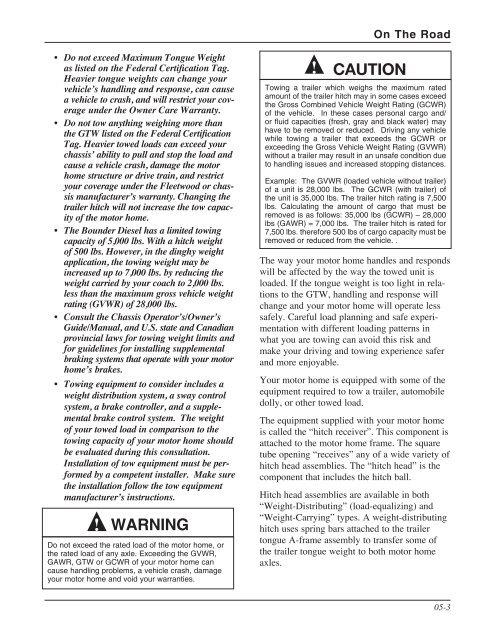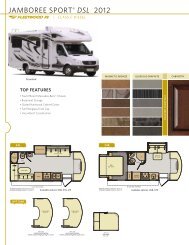Create successful ePaper yourself
Turn your PDF publications into a flip-book with our unique Google optimized e-Paper software.
• Do not exceed Maximum Tongue Weight<br />
as listed on the Federal Certification Tag.<br />
Heavier tongue weights can change your<br />
vehicle’s handling and response, can cause<br />
a vehicle to crash, and will restrict your coverage<br />
under the Owner Care Warranty.<br />
• Do not tow anything weighing more than<br />
the GTW listed on the Federal Certification<br />
Tag. Heavier towed loads can exceed your<br />
chassis’ ability to pull and stop the load and<br />
cause a vehicle crash, damage the motor<br />
home structure or drive train, and restrict<br />
your coverage under the <strong>Fleetwood</strong> or chassis<br />
manufacturer’s warranty. Changing the<br />
trailer hitch will not increase the tow capacity<br />
of the motor home.<br />
• The Bounder Diesel has a limited towing<br />
capacity of 5,000 lbs. With a hitch weight<br />
of 500 lbs. However, in the dinghy weight<br />
application, the towing weight may be<br />
increased up to 7,000 lbs. by reducing the<br />
weight carried by your coach to 2,000 lbs.<br />
less than the maximum gross vehicle weight<br />
rating (GVWR) of 28,000 lbs.<br />
• Consult the Chassis Operator’s/Owner’s<br />
Guide/Manual, and U.S. state and Canadian<br />
provincial laws for towing weight limits and<br />
for guidelines for installing supplemental<br />
braking systems that operate with your motor<br />
home’s brakes.<br />
• Towing equipment to consider includes a<br />
weight distribution system, a sway control<br />
system, a brake controller, and a supplemental<br />
brake control system. The weight<br />
of your towed load in comparison to the<br />
towing capacity of your motor home should<br />
be evaluated during this consultation.<br />
Installation of tow equipment must be performed<br />
by a competent installer. Make sure<br />
the installation follow the tow equipment<br />
manufacturer’s instructions.<br />
!<br />
WARNING<br />
Do not exceed the rated load of the motor home, or<br />
the rated load of any axle. Exceeding the GVWR,<br />
GAWR, GTW or GCWR of your motor home can<br />
cause handling problems, a vehicle crash, damage<br />
your motor home and void your warranties.<br />
!<br />
CAUTION<br />
On The Road<br />
Towing a trailer which weighs the maximum rated<br />
amount of the trailer hitch may in some cases exceed<br />
the Gross Combined Vehicle Weight Rating (GCWR)<br />
of the vehicle. In these cases personal cargo and/<br />
or fluid capacities (fresh, gray and black water) may<br />
have to be removed or reduced. Driving any vehicle<br />
while towing a trailer that exceeds the GCWR or<br />
exceeding the Gross Vehicle Weight Rating (GVWR)<br />
without a trailer may result in an unsafe condition due<br />
to handling issues and increased stopping distances.<br />
Example: The GVWR (loaded vehicle without trailer)<br />
of a unit is 28,000 lbs. The GCWR (with trailer) of<br />
the unit is 35,000 lbs. The trailer hitch rating is 7,500<br />
lbs. Calculating the amount of cargo that must be<br />
removed is as follows: 35,000 lbs (GCWR) – 28,000<br />
lbs (GAWR) = 7,000 lbs. The trailer hitch is rated for<br />
7,500 lbs. therefore 500 lbs of cargo capacity must be<br />
removed or reduced from the vehicle. .<br />
The way your motor home handles and responds<br />
will be affected by the way the towed unit is<br />
loaded . If the tongue weight is too light in relations<br />
to the GTW, handling and response will<br />
change and your motor home will operate less<br />
safely . Careful load planning and safe experimentation<br />
with different loading patterns in<br />
what you are towing can avoid this risk and<br />
make your driving and towing experience safer<br />
and more enjoyable .<br />
Your motor home is equipped with some of the<br />
equipment required to tow a trailer, automobile<br />
dolly, or other towed load .<br />
The equipment supplied with your motor home<br />
is called the “hitch receiver” . This component is<br />
attached to the motor home frame . The square<br />
tube opening “receives” any of a wide variety of<br />
hitch head assemblies . The “hitch head” is the<br />
component that includes the hitch ball .<br />
Hitch head assemblies are available in both<br />
“Weight-Distributing” (load-equalizing) and<br />
“Weight-Carrying” types . A weight-distributing<br />
hitch uses spring bars attached to the trailer<br />
tongue A-frame assembly to transfer some of<br />
the trailer tongue weight to both motor home<br />
axles .<br />
05-3






